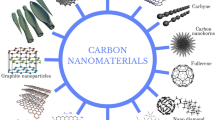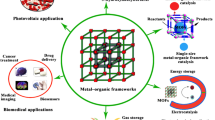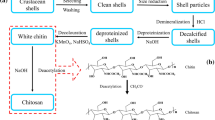Abstract
Polyacrylamide/functionalized multiwalled carbon nanotubes (PAAm/FMWCNTs) composites were prepared by different polymerization techniques using gamma radiation as an initiator. These polymerization techniques were template polymerization of acrylic acid (AA) onto PAAm/FMWCNTs (N1), template polymerization of acrylamide (AAm) onto PAAm/FMWCNTs (N2), copolymerization of AA and AAm onto FMWCNTs (N3), and in situ polymerization of AAm from FMWCNTs surface (N4). The composites were analyzed by FTIR, SEM, and TGA. The composites were applied for the removal of Cu(II) metal ions by the batch adsorption method. The adsorption was investigated under various experimental conditions including initial pH, contact time, composites dosage, the concentration of Cu(II) metal ions, and temperature. The adsorption capacities of N1, N2, N3, and N4 composites were 385.44, 330.23, 351.95, and 320.29 mg/g, respectively, at a contact time: 90 min, initial concentration of Cu(II) metal ions: 0.8 g/L, the temperature: 25 °C, rpm: 150, pH: 5. and V/m: 1 L/g. The adsorption experimental results were closer to pseudo-second-order and Langmuir adsorption models. Thermodynamic data showed that the adsorption process was endothermic. The desorption studies have shown that PAAm/FMWCNTs composites adsorbents have a good adsorption/desorption performance for Cu(II) metal ions.









Similar content being viewed by others
References
Al-saydeh SA, El-naas MH, Zaidi SJ (2017) Copper removal from industrial wastewater : a comprehensive review. J Ind Eng Chem 56:35–44. https://doi.org/10.1016/j.jiec.2017.07.026
Aydın H, Bulut Y, Yerlikaya C (2008) Removal of copper(II) from aqueous solution by adsorption onto low-cost adsorbents. J Environ Manage 87:37–45. https://doi.org/10.1016/j.jenvman.2007.01.005
Verbych S, Bryk M, Chornokur G, Fuhr B (2005) Separation science and technology removal of copper ( ii ) from aqueous solutions by chitosan adsorption. Sep Sci Technol 40:1749–1759
Yantasee W, Lin Y, Fryxell GE et al (2004) Selective removal of copper (II) from aqueous solutions using fine-grained activated carbon functionalized with amine. Ind Eng Chem Res 43:2759–2764
Abdelmonem IM, Metwally E, Siyam TE et al (2019) Radiation synthesis of starch-acrylic acid–vinyl sulfonic acid/multiwalled carbon nanotubes composite for the removal of 134Cs and 152 + 154Eu from aqueous solutions. J Radioanal Nucl Chem 319:1145–1157. https://doi.org/10.1007/s10967-018-6392-1
El-Sweify FH, Abdelmonem IM, El-Masry AM et al (2019) Adsorption behavior of Co(II) and Eu(III) on polyacrylamide/multiwalled carbon nanotube composites. Radiochemistry 61:323–330. https://doi.org/10.1134/S106636221903007X
Abdelmonem IM, Metwally E, Siyam TE et al (2019) Adsorption of 60Co from aqueous solution onto alginate–acrylic acid–vinylsulfonic acid/multiwalled carbon nanotubes composite. Polym Bull. https://doi.org/10.1007/s00289-019-02978-7
Siyam T (2001) Development of acrylamide polymers for the treatment of wastewater. Des Monomers Polym 4:107–168. https://doi.org/10.1163/156855500300203377
Iijima S (1991) Helicial microtubules of graphitic carbon. Lett To Nat 354:56–58
Spitalsky Z, Tasis D, Papagelis K, Galiotis C (2010) Carbon nanotube-polymer composites: chemistry, processing, mechanical and electrical properties. Prog Polym Sci 35:357–401. https://doi.org/10.1016/j.progpolymsci.2009.09.003
Kim H-S, Il KH, Yun YS et al (2011) Nanoporous silica membranes fabricated using multiwalled carbon nanotubes. J Nanosci Nanotechnol 11:4434–4438. https://doi.org/10.1166/jnn.2011.3655
Saito N, Usui Y, Aoki K et al (2009) Carbon nanotubes: biomaterial applications. Chem Soc Rev 38:1897–1903. https://doi.org/10.1039/b804822n
Liu Z, Tabakman S, Welsher K, Dai H (2009) Carbon nanotubes in biology and medicine: in vitro and in vivo detection, imaging and drug delivery. Nano Res 2:85–120. https://doi.org/10.1007/s12274-009-9009-8
Nabid MR, Sedghi R, Hajimirza R et al (2011) A nanocomposite made from conducting organic polymers and multi-walled carbon nanotubes for the adsorption and separation of gold(III) ions. Microchim Acta 175:315–322. https://doi.org/10.1007/s00604-011-0680-6
Duran A, Tuzen M, Soylak M (2009) Preconcentration of some trace elements via using multiwalled carbon nanotubes as solid phase extraction adsorbent. J Hazard Mater 169:466–471. https://doi.org/10.1016/j.jhazmat.2009.03.119
Sitko R, Zawisza B, Malicka E (2012) Modification of carbon nanotubes for preconcentration, separation and determination of trace-metal ions. TrAC - Trends Anal Chem 37:22–31. https://doi.org/10.1016/j.trac.2012.03.016
Şenol ZM, Şenol Arslan D, Şimşek S (2019) Preparation and characterization of a novel diatomite-based composite and investigation of its adsorption properties for uranyl ions. J Radioanal Nucl Chem 321:791–803. https://doi.org/10.1007/s10967-019-06662-y
Şenol ZM, Şimşek S, Ulusoy Hİ, Özer A (2020) Synthesis and characterization of a polyacrylamide-dolomite based new composite material for efficient removal of uranyl ions. J Radioanal Nucl Chem 324:317–330. https://doi.org/10.1007/s10967-020-07047-2
Şenol ZM, Şimşek S, Ulusoy Hİ et al (2020) Insight from adsorption properties of Xylidyl Blue embedded hydrogel for effective removal of uranyl: experimental and theoretical approaches. Polym Test. https://doi.org/10.1016/j.polymertesting.2020.106566
Kaşgöz H, Özgümüš S, Orbay M (2003) Modified polyacrylamide hydrogels and their application in removal of heavy metal ions. Polymer (Guildf) 44:1785–1793. https://doi.org/10.1016/S0032-3861(03)00033-8
Kalaivani SS, Vidhyadevi T, Murugesan A et al (2014) The use of new modified poly(acrylamide) chelating resin with pendent benzothiazole groups containing donor atoms in the removal of heavy metal ions from aqueous solutions. Water Resour Ind 5:21–35. https://doi.org/10.1016/j.wri.2014.04.001
Ma J, Zhou G, Chu L et al (2017) Efficient removal of heavy metal ions with an EDTA functionalized chitosan/polyacrylamide double network hydrogel. ACS Sustain Chem Eng 5:843–851. https://doi.org/10.1021/acssuschemeng.6b02181
Abdelmonem IM (2015) Studies on the use of gamma radiation-induced preparation of polyacrylamide-carbon nanotube composites for potential applications. Faculty of Science, Zagazig University, Zagazig, Egypt
Gizawy MA, Aydia MI, Abdel Monem IM et al (2019) Radiochemical separation of reactor produced Sc-47 from natural calcium target using Poly(acrylamide-acrylic acid)/multi-walled carbon nanotubes composite. Appl Radiat Isot 150:87–94. https://doi.org/10.1016/j.apradiso.2019.05.022
Ibrahim AG, Saleh AS, Elsharma EM et al (2019) Gamma radiation-induced preparation of poly(1-vinyl-2-pyrrolidone-co-sodium acrylate) for effective removal of Co(II), Ni(II), and Cu(II). Polym Bull 76:303–322. https://doi.org/10.1007/s00289-018-2379-x
Dinu MV, Dragan ES (2010) Evaluation of Cu2+, Co2+ and Ni2+ ions removal from aqueous solution using a novel chitosan/clinoptilolite composite: kinetics and isotherms. Chem Eng J 160:157–163. https://doi.org/10.1016/j.cej.2010.03.029
Demiral H, Güngor C (2016) Adsorption of copper(II) from aqueous solutions on activated carbon prepared from grape bagasse. J Clean Prod 124:103–113. https://doi.org/10.1016/j.jclepro.2016.02.084
Solpan D, Torun M, Guven O (2008) The Usability of (sodium alginate/acrylamide) semi-interpenetrating polymer networks on removal of some textile dyes dilek. J Appl Polym Sci 108:3787–3795. https://doi.org/10.1002/app
Abdelmonem IM, Metwally E, Siyam TE et al (2020) Gamma radiation-induced preparation of chitosan-acrylic acid-1-vinyl-2-vinylpyrrolidone/multiwalled carbon nanotubes composite for removal of 152 + 154Eu, 60Co and 134Cs radionuclides. Int J Biol Macromol 164:2258–2266. https://doi.org/10.1016/j.ijbiomac.2020.08.120
Gizawy MA, Shamsel-Din HA, Abdelmonem IM et al (2020) Synthesis of chitosan-acrylic acid/multiwalled carbon nanotubes composite for theranostic 47Sc separation from neutron irradiated titanium target. Int J Biol Macromol 163:79–86
Schweitzer GK, Pesterfiel LL (2010) The aqueous chemistry of the elements. Oxford, New York. https://doi.org/10.1093/oso/9780195393354.001.0001
Şenol ZM, Şimşek S (2020) Equilibrium, kinetics and thermodynamics of Pb(II) ions from aqueous solution by adsorption onto chitosan-dolomite composite beads. Int J Environ Anal Chem. https://doi.org/10.1080/03067319.2020.1790546
Gök C (2017) Equilibrium, kinetic and thermodynamic studies of europium adsorption by biopolymeric composite. Int J Chem Eng Appl 8:334–339. https://doi.org/10.18178/ijcea.2017.8.5.679
Amini M, Younesi H, Bahramifar N (2013) Biosorption of U(VI) from aqueous solution by Chlorella vulgaris : equilibrium, kinetic, and thermodynamic studies. J Environ Eng 139:410–421. https://doi.org/10.1061/(ASCE)EE.1943-7870.0000651
Sun J, Li Y, Liu T et al (2014) Equilibrium, kinetic and thermodynamic studies of cationic red X-Grl adsorption on graphene oxide. Environ Eng Manag J 13:2551–2559. https://doi.org/10.1016/j.materresbull.2012.04.021
Suguna M, Siva Kumar N (2013) Equilibrium, kinetic and thermodynamic studies on biosorption of lead(II) and cadmium(II) from aqueous solution by polypores biomass. Indian J Chem Technol 20:57–69
Abdelmonem IM (2019) Natural polymer–carbon nanotube composites prepared by gamma radiation for the removal of some radionuclides. Faculty of Science, Ain Shams University, Abassia, Cairo, Egypt
Rainert KT, Nunes HCA, Gonçalves MJ, Tavares BLB (2017) Equilibrium, kinetic and thermodynamic studies on the removal of reactive dye RBBR using discarded SBS paperboard coated with PET as an adsorbent. Desalin Water Treat 86:203–212. https://doi.org/10.5004/dwt.2017.21299
Haroon H, Ashfaq T, Gardazi SMH et al (2016) Equilibrium kinetic and thermodynamic studies of Cr(VI) adsorption onto a novel adsorbent of Eucalyptus camaldulensis waste: batch and column reactors. Korean J Chem Eng 33:2898–2907. https://doi.org/10.1007/s11814-016-0160-0
Alqadami AA, Naushad M, Abdalla MA et al (2016) Adsorptive removal of toxic dye using Fe3O4−TSC nanocomposite: equilibrium, kinetic, and thermodynamic studies. J Chem Eng Data 61:3806–3813. https://doi.org/10.1021/acs.jced.6b00446
Xu L, Zheng X, Cui H et al (2017) Equilibrium, kinetic and thermodynamic studies on the adsorption of cadmium from aqueous solution by modified biomass ash. Bioinorg Chem Appl 2017:1–9. https://doi.org/10.1155/2017/3695604
Liu LE, Liu J, Li H et al (2012) Equilibrium, kinetic and thermodynamic studies of lead (II) biosorption on sesame leaf. BioResources 7:3555–3572
Achmad A, Kassim J, Suan TK et al (2012) Equilibrium, kinetic and thermodynamic studies on the adsorption of direct dye onto a novel green adsorbent developed from Uncaria gambir extract. J Phys Sci 23:1–13
Huang Q, Lin X, Xiong L et al (2017) Equilibrium kinetic and thermodynamic studies of acid soluble lignin adsorption from rice straw hydrolysate by a self-synthesized macromesoporous resin. RSC Adv 7:23896–23906
Qiang H, Jiao Z, Meiying L et al (2018) Synthesis of polyacrylamide immobilized molybdenum disulfide (MoS2@PDA@PAM) composites via mussel-inspired chemistry and surface-initiated atom transfer radical polymerization for removal of copper(II) ions. J Taiwan Inst Chem Eng. https://doi.org/10.1016/j.jtice.2017.12.027
Mondal S, Majumder SK (2019) Honeycomb-like porous activated carbon for efficient copper(II) adsorption synthesized from natural source : kinetic study and equilibrium isotherm analysis. J Environ Chem Eng. https://doi.org/10.1016/j.jece.2019.103236
Mbouga N, Goletti M, Giscard KK et al (2018) Adsorption of copper(II) ions from aqueous solutions by using natural saponins-clay modified materials: isotherm, kinetic and thermodynamics. Am J Chem 8:29–35. https://doi.org/10.5923/j.chemistry.20180802.01
Shah PU, Raval NP, Shah NK (2015) Adsorption of copper from an aqueous solution by chemically modified cassava starch. J Mater Environ Sci 6:2573–2582
Wang J, Li Z, Li S et al (2013) Adsorption of Cu(II) on oxidized multi-walled carbon nanotubes in the presence of hydroxylated and carboxylated fullerenes. PLoS ONE 8:1–11. https://doi.org/10.1371/journal.pone.0072475
Moulay S, Bensacia N, Garin F et al (2013) Polyacrylamide-based sorbents for the removal of hazardous metals. Adsorpt Sci Technol 31:691–709. https://doi.org/10.1260/0263-6174.31.8.691
Acknowledgements
The authors are grateful to the staff of the Nuclear Chemistry Department, Hot Laboratories Centre, Egyptian Atomic Energy Authority, for their valuable support in the research.
Author information
Authors and Affiliations
Corresponding author
Additional information
Publisher's Note
Springer Nature remains neutral with regard to jurisdictional claims in published maps and institutional affiliations.
Rights and permissions
About this article
Cite this article
Abo-Zahra, S.F., Abdelmonem, I.M., Siyam, T.E. et al. Radiation synthesis of polyacrylamide/functionalized multiwalled carbon nanotubes composites for the adsorption of Cu(II) metal ions from aqueous solution. Polym. Bull. 79, 4395–4415 (2022). https://doi.org/10.1007/s00289-021-03726-6
Received:
Revised:
Accepted:
Published:
Issue Date:
DOI: https://doi.org/10.1007/s00289-021-03726-6




